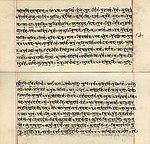Comparative religion
From Wikipedia, the free encyclopedia

Comparative religion is a field of religious study that analyzes the similarities and differences of themes, myths, rituals and concepts among the world's religions. Religion can be defined as the human notions regarding the sacred, numinous, spiritual or divine.[1]
In the field of comparative religion, the main world religions are generally classified as either Abrahamic, Indian or Taoic. Areas of study also include creation myths and Humanism.
Contents |
[edit] Abrahamic religions
In the study of comparative religion, the category of Abrahamic religions consists of the three monotheistic religions, Christianity, Islam and Judaism, which claim Abraham (Hebrew Avraham אַבְרָהָם ; Arabic Ibrahim ابراهيم ) as a part of their sacred history. Other religions (such as the Bahá'í Faith) that fit this description are sometimes included but are often omitted.[2]
The original belief in the One God of Abraham eventually became present-day Judaism. Christians believe that Christianity is the fulfillment and continuation of the Jewish Old Testament, with Jesus as the messiah of Old Testament prophecy and subsequent New Testament teachings and continued prophecy. Islam believes the present Christian and Jewish scriptures have been modified over time and are no longer the original divine revelations as given to Moses, Jesus, and other prophets. For Muslims the Qur'an is the final revelation from God, with Muhammad as his messenger for its transmission.
[edit] Comparing Abrahamic religions

Christianity and Judaism are two closely related Abrahamic religions that in some ways parallel each other and in other ways fundamentally diverge in theology and practice. The article on Judeo-Christian tradition emphasizes continuities and convergences between the two religions. The article on Christianity and Judaism compares the different views held by both religions.
The historical interaction of Islam and Judaism started in the 7th century CE with the origin and spread of Islam. There are many common aspects between Islam and Judaism, and as Islam developed it gradually became the major religion closest to Judaism. As opposed to Christianity which originated from interaction between ancient Greek and Hebrew cultures, Judaism is very similar to Islam in its fundamental religious outlook, structure, jurisprudence and practice.[3] There are many traditions within Islam originating from traditions within the Hebrew Bible or from postbiblical Jewish traditions. These practices are known collectively as the Isra'iliyat.[4]
The historical interaction between Christianity and Islam connects fundamental ideas in Christianity with similar ones in Islam. Islam and Christianity share their origins in the Abrahamic tradition, although Christianity predates Islam by centuries. Islam accepts many aspects of Christianity as part of its faith - with some differences in interpretation - and rejects other aspects. Islam believes the Qur'an is the final revelation from God and a completion of all previous revelations, including the Bible.
[edit] Indian religions
There are a number of religions that have originated on the Indian subcontinent. They encompass Hinduism, Buddhism, Jainism, and Sikhism.
The religion of the Vedic period is the historical predecessor of the Hindu religion. The Vedic and the Sramana tradition co-existed and influenced each other since pre-historic times. Jainism and Buddhism are a continuation of the Sramana tradition. Buddhism further diversified, into Chinese and Japanese schools.
[edit] Comparing "Dharmic" religions

Buddhism and Hinduism are both post-Vedic religions. Gautama Buddha is mentioned as an Avatar of Vishnu in the Puranic texts of Hinduism. Some Hindus believe the Buddha accepted and incorporated many tenets of Hinduism in his doctrine, however, Buddhists disagree and state there was no such thing as Hinduism at the time of Buddha and in fact, "Indeed, it absorbed so many Buddhist traits that it is virtually impossible to distinguish the latter in medieval and later Hinduism."[5] Prominent Hindu reformers such as Gandhi[6] and Vivekananda[7] acknowledge Buddhist influence.
Buddhism and Jainism are the two branches of the Shramana tradition that still exist today. Until recently Jainism was largely confined to India, while Buddhism has largely flourished outside of India. However the two traditions share remarkable similarities. In his life, the Buddha undertook many fasts, penances and austerities, the descriptions of which are elsewhere found only in the Jain tradition. Ultimately Buddha abandoned these methods on his discovery of the Middle Way or Magga. To this day, many Buddhist teachings, principles, and terms used in Buddhism are identical to those of Jainism, but they may hold very different meanings for each.
Hinduism and Sikhism have had a long and complex relationship. Views range from Sikhism being a distinct faith in itself to Sikhism being a sect of Hinduism. A vast majority of Sikhs oppose the notion that Sikhism is a sect of Hinduism, while others stress the similarities, but recognise that the religions are distinct.
Jainism and Sikhism have both originated in South Asia and are Eastern philosophical faiths. Jainism, like Buddhism, rejected the authority of the Vedas and created independent textual traditions based on the words and examples of their early teachers.
[edit] Taoic religions
A Taoic religion is a religion, or religious philosophy, that focuses on the East Asian concept of Tao ("The Way"). This forms a large group of religions including Taoism, Confucianism, Jeung San Do, Shinto, Yiguandao, Chondogyo, Chen Tao and Caodaism. In large parts of East Asia, Buddhism has taken on some taoic features.
Tao can be roughly stated to be the flow of the universe, or the force behind the natural order. It is believed to be the influence that keeps the universe balanced and ordered and is associated with nature, due to a belief that nature demonstrates the Tao. The flow of Chi, as the essential energy of action and existence, is compared to the universal order of Tao. Following the Tao is also associated with a "proper" attitude, morality and lifestyle. This is intimately tied to the complex concept of De, or literally "virtue". De is the active expression of Tao.
Taoism and Ch'an Buddhism for centuries had a mutual influence on each other in China, Korea and Vietnam. These influences were inherited by Zen-Buddhism when Ch'an Buddhism arrived in Japan and adapted as Zen-Buddhism.
[edit] Comparing Taoic religions
[edit] Comparing between traditions
Buddhism
Christianity
Confucianism
Hinduism
Islam
Jainism
Taoism
Zoroastrianism
[edit] Mysticism and Esotericism
- Kabbalah (Judaism)
- Gnosticism (Christianity)
- Sufism (Islam)
- Magi (Zoroastrianism)
- Yoga, Chakra (Hinduism)
- Vajrayana (Buddhism)
- Tantra (Hinduism, Buddhism)
- Ideal perfection: "Baqa" (Sufism), 'Najat' (Islam), 'Nirvana' (Buddhism), 'Salvation' (Christianity), and 'Mukti' (Hinduism).
- Thelema
[edit] See also
- Comparative mythology
- Hierographology
- Inclusivism
- Institute for Interreligious Dialogue
- List of religions
- Religion
- Religious pluralism
[edit] References
| This article needs additional citations for verification. Please help improve this article by adding reliable references (ideally, using inline citations). Unsourced material may be challenged and removed. (June 2007) |
- ^ "Human beings' relation to that which they regard as holy, sacred, spiritual, or divine" Encyclopædia Britannica (online, 2006), cited after What is Religion? Definitions and Quotes.
- ^ Why Abrahamic? Lubar Institute for the Study of the Abrahamic Religions at the University of Wisconsin
- ^ Rabbi David Rosen, Jewish-Muslim Relations, Past and Present, November 2003
- ^ Rabbi Justin Jaron Lewis, Islam and Judaism, October 2001
- ^ MLA style: "monasticism." Encyclopædia Britannica. 2007. Encyclopædia Britannica Online. 14 Aug. 2007 <http://www.britannica.com/eb/article-38700>.
- ^ “owes on eternal debt of gratitude to that great teacher,”Mahatma Gandhi and Buddhism Y.P. Anand An Encounter with Buddhism http://www.iop.or.jp/0414/anand.pdf
- ^ He is the ideal Karma-Yogi, acting entirely without motive, and the history of humanity shows him to have been the greatest man ever born; beyond compare the greatest combination of heart and brain that ever existed, the greatest soul-power that has ever been manifested. Essay, Ideal Karma Yogi http://www.geocities.com/Athens/Olympus/5208/karmayoga/ideal.html
[edit] Further reading
- Ankerl, Guy. Global communication without universal civilization. INU societal research. Vol.1: Coexisting contemporary civilizations : Arabo-Muslim, Bharati, Chinese, and Western. Geneva: INU Press. ISBN 2-88155-004-5.
[edit] External links
- 2nd International Online-Conference "Comparative Religion: from Subject to Problem"
- ReligiousTolerance.org
- Academicinfo.net
- ReligionFacts.com
- Comparative-religion.com
- Studies in Comparative Religion
- Study of Comparative Religions in Indian Universities
|
|||||||||||||||||||||||||||||||||||||||||||||||||||



